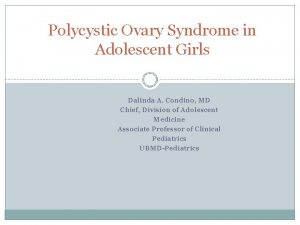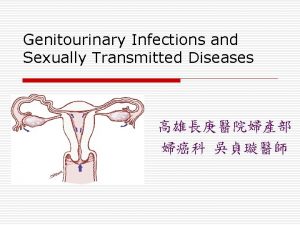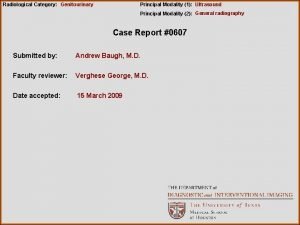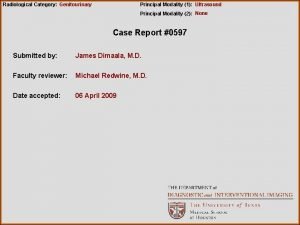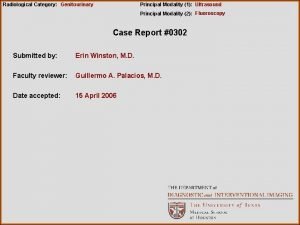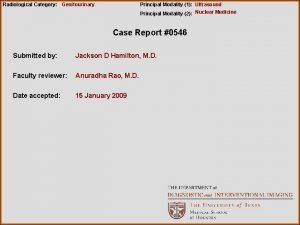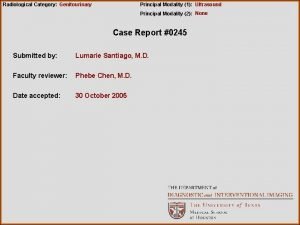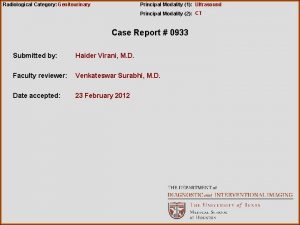Radiological Category Genitourinary Principal Modality 1 Ultrasound Principal














- Slides: 14

Radiological Category: Genitourinary Principal Modality (1): Ultrasound Principal Modality (2): None Case Report #0245 Submitted by: Lumarie Santiago, M. D. Faculty reviewer: Phebe Chen, M. D. Date accepted: 30 October 2005

Case History 45 year old woman, G 2 P 2, presents with irregular menstrual cycles and intermittent spotting.

Radiological Presentations TRANSVAGINAL ULTRASOUND Sagittal views of the uterus show heterogeneous echogenicity along the expected location of the endometrial stripe which is indistinct and thickened in the fundus. No discrete vascular pedicle or associated increased vascularity is noted.

Radiological Presentations TRANSVAGINAL ULTRASOUND • Transverse view of the uterus confirms the indistinct endometrial stripe. A heterogeneous mass with posterior acoustic shadowing is suspected. • Transverse image of the mid uterine segment shows a hyperechoic line anterior to the area of heterogeneity.

Radiological Presentations TRANSVAGINAL ULTRASOUND Small amount of fluid in the endometrial cavity is seen (arrow).

Test Your Diagnosis Which one of the following is your choice for the appropriate diagnosis? After your selection, go to next page. • Endometrial polyp • Normal premenopausal proliferative endometrium • Submucosal fibroid • Endometrial carcinoma • Endometrial hyperplasia What would you do next? • Follow up ultrasound in 6 weeks • Hysterosonogram • Pelvic MR • Endometrial biopsy

Radiological Presentations HYSTEROSONOGRAM • A large, predominantly hypoechoic but heterogeneous mass with posterior acoustic shadowing extends into the endometrial cavity from the posterior myometrium. There is also focal thickening of the endometrium along the anterior lower uterine segment (arrowhead). • There is echogenic tissue (arrows) overlying the heterogeneous mass.

Radiological Presentations HYSTEROSONOGRAM • A focal, uniformly echogenic mass with broad base attachment protrudes into the endometrial cavity and is continuous with the endometrial lining (arrows). • The catheter appears as an echogenic, thick line with posterior acoustic shadowing in the lower uterine segment (arrowhead).

Radiological Presentations HYSTEROSONOGRAM Echogenic focus in the superior aspect of the endocervical canal (arrow) noted while simultaneously instilling saline, deflating and withdrawing the balloon.

Differential Diagnosis • Submucosal fibroid • Endometrial polyp • Endometrial carcinoma • Focal endometrial thickening

Discussion Endometrial disease is often suspected when patients present with changes in their menstrual cycles (meno, metro or metro-menorrhagia). Initial evaluation of these patients includes a transvaginal ultrasound. Often the only abnormality seen is endometrial thickening. Many management options exist including blind endometrial biopsy, dilatation and curettage (D/C), hysteroscopy and hysterosonography. Endometrial biopsy and D/C may be performed if diffuse disease is suspected. Hysteroscopy is best for focal endometrial disease as biopsy may be performed under direct visualization. Hysterosonography may help distinguish between diffuse and focal endometrial disease. Focal disease may be caused by endometrial polyps, submucosal fibroids and asymmetric endometrial thickening which may be caused by endometrial hyperplasia or carcinoma. Diffuse disease may be caused by a proliferative endometrium, endometrial hyperplasia or endometrial carcinoma. Focal disease may be suspected initially when multiple cystic spaces are present within a thickened endometrial complex that is associated with a peripheral hyperechoic line. This line represents one or both layer of the endometrial lining itself. there In our case the initial transverse transvaginal images demonstrate thickening of the endometrial complex and suggest an incomplete peripheral hyperechoic line. In the absence of cystic spaces, the hysterosonogram would better define the focal nature of our findings which may be secondary to an endometrial polyp, submucosal fibroid or endometrial hyperplasia.

Discussion Endometrial polyps may be sessile or pedunculated, but usually have a narrow base of attachment best seen by hysteroscopy and hysterosonography. They are hyperechoic and most have internal cystic spaces. These may be suspected on transvaginal ultrasound by the presence of a hyperechoic line overlying a thickened endometrial complex that also has internal cystic spaces. Submucosal fibroids have a wide attachment to the myometrium and are heterogeneous in echogenicity. An overlying rim of endometrium is seen as in this case. Focal endometrial thickening may simulate both polyps and submucosal fibroids. Unlike polyps, focal endometrial thickening usually has a broad base of attachment as in our case. Unlike submucosal fibroids, focal endometrial thickening lacks the overlying endometrial mucosa as it is continuous with the endometrial lining. When there is diffuse thickening of the endometrium without focal asymmetry, blind endometrial biopsy may be performed as it may be secondary to endometrial hyperplasia, carcinoma or physiologic proliferative endometrium. It is important to also evaluate the lower uterine segment. This area is best evaluated during the tail end of the hysterosonographic study by instilling saline while deflating and withdrawing the balloon and ensures that lesions near the lower uterine segment are not overlooked.

Diagnosis Posterior fundal submucosal fibroid, focal asymmetric endometrial thickening and endocervical polyp.

References • Baldwin MT, et al. Focal intracavitary masses recognized with the hyperechoic line sign at endovaginal us and characterized with hysterosonography. Radio. Graphics 1999: 19; 927 -935. • Kurtz AB and Middleton WD. Ultrasound: the requisites. 1 st Ed 1996 Mosby pp 368374.
 Ferriman-gallwey score
Ferriman-gallwey score Erate category 2 eligible equipment
Erate category 2 eligible equipment Radiological dispersal device
Radiological dispersal device Tennessee division of radiological health
Tennessee division of radiological health Center for devices and radiological health
Center for devices and radiological health National radiological emergency preparedness conference
National radiological emergency preparedness conference Chapter 29 the child with a genitourinary condition
Chapter 29 the child with a genitourinary condition Genitourinary & stds
Genitourinary & stds Male genitourinary anatomy
Male genitourinary anatomy Chapter 29 the child with a genitourinary condition
Chapter 29 the child with a genitourinary condition Nursing care of male patients with genitourinary disorders
Nursing care of male patients with genitourinary disorders Pacs modality workstation
Pacs modality workstation Swd modality
Swd modality Modality microsoft services
Modality microsoft services Modality
Modality
